Pine turns yellow: reasons and methods of struggle
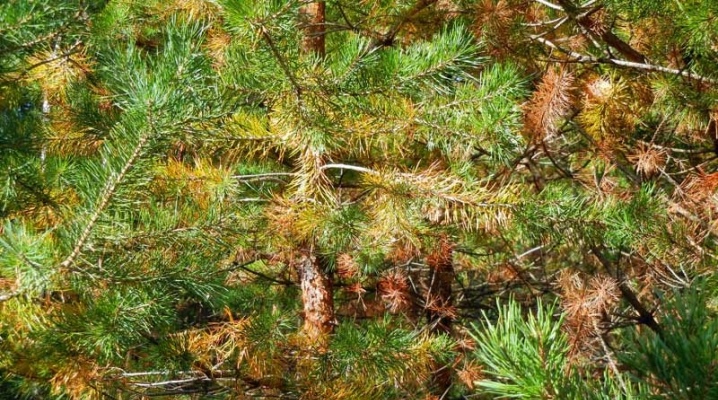
It has become very fashionable to plant a plant such as a pine in your personal plot. These trees also ennoble park alleys. People fell in love with this evergreen for a reason. It has multiple positive qualities. With the help of pine, a person receives aesthetic pleasure and the opportunity to improve his health. Some even use buds as the main ingredient for delicious jams. And how the mood spoils when a beautiful and healthy tree suddenly begins to ache!
Description of culture
Pine is a light-loving plant. It blooms in spring, and cones become the result of flowering. It develops in breadth and upward for a hundred years. Some specimens can reach 75 meters in height. The final appearance of the pine is formed by the shoots, which eventually grow stiff. This thorny representative of the flora has two-, three- and five-coniferous species. The trunk is either curved or straight. The shape of the crown varies from species and is divided into conical, rounded, creeping and pin-shaped.
The plant is unpretentious and has a winding root system. They can spread up to 9 meters or more due to habitat conditions. Pine does not like polluted air, but it is resistant to frost.
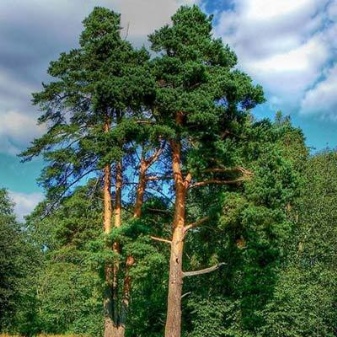
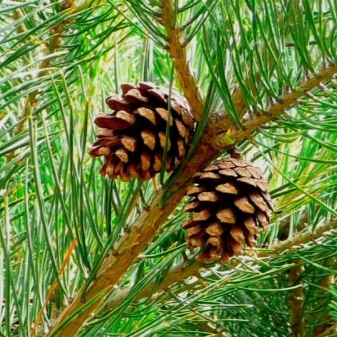
In most cases, pines grow in the Northern Hemisphere. They also live in northern Africa and the Arctic Circle. Their views are amazing.
- There is a cedar pine (Siberian). This is the close sister of the Scots pine. Grows in Western and Eastern Siberia.
- Scots pine exists in Europe and Asia. Essential oils and rosin are obtained from it.
- The massive tree is swamp pine. It grows in North America.
- White pine or Montezuma pine also grows in North America.
- Low bushy tree - dwarf pine. It is often found from Primorye to Kamchatka.
- Mountain pine is a tree-like shrub. It is widely used in landscaping around the world.
- Pallas pine (Crimean) - a rare species, therefore it is in the Red Book. Grows up to 45 meters.
- Has a smooth light gray bark white pine... It is characterized by an uneven or vertical trunk with a length of about 21 meters. Grows in North America.
- A beautiful tree is the Pinia pine. It looks like an umbrella. Recognized as an ornamental breed and common in bonsai culture. It is also cultivated in the Crimea and the North Caucasus.
- Tall graceful tree - Himalayan pine. It is cultivated all over the world as an ornamental plant.
- Black pine grows in the northern part of the Mediterranean. Used for decorative purposes in landscape design.
- The Scots pine ecotype is Angara pine. Grows in the Krasnoyarsk Territory. It grows up to 50 meters in height.
- Weymouth pine (white pine) grows in North America. Grows up to 70 meters. It is used in construction and forestry.
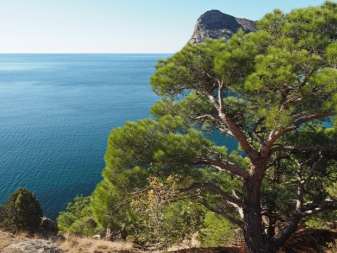
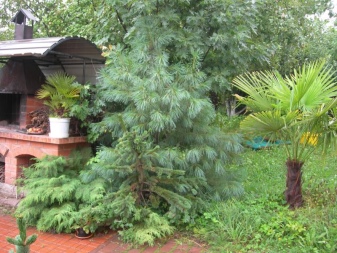
Planting and care
So that in the future there are no problems with the plant, it must be properly planted. For planting, seedlings are used that are 3-7 years old. In this case, the root system must be closed. Otherwise, they will die within 15 minutes. For planting, purchase a plant in the region in which you live. The optimal time for planting pine trees is spring (late April and May) and autumn (late August and September).
Best of all, seedlings take root in sandy soil. Dig a hole about one meter deep.If the soil is heavy, then carry out additional drainage (place expanded clay or broken brick on the bottom of the pit). If it is acidic, add 200 g of lime to it and supplement it with various dressings (they are purchased in a garden goods store). Before planting, the plant is immersed in water for 3 hours without removing it from the container.
Immediately before planting, remove the plant from the container and immerse it in the prepared hole. In this case, pour part of the soil mixture on the bottom, and then, placing the roots, fill them with the rest of it. During planting, it is necessary to pour about 20 liters of water under the roots. When the water is absorbed, the root collar of the seedling should remain outside your plant. When planting several seedlings at once, keep a distance of about 4 meters.
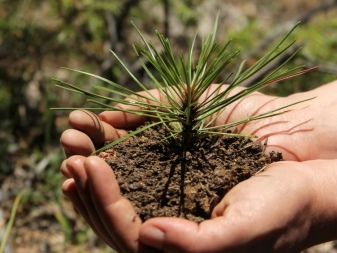
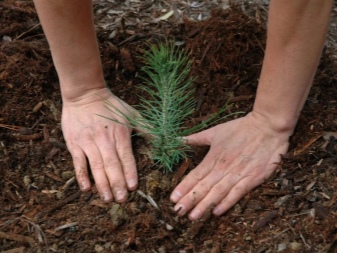
Young plants need additional watering. However, you cannot overdo it with him, if the autumn weather is outside.
In order for the seedlings to take root better, they must be fed with mineral fertilizers. So that your young pine tree does not die, it should be covered with special material for the winter. When the tree grows up, the crown is pruned and diseased branches are removed.
Transplanting conifers should be done in the spring. Transplanted conifers do not take root well if you take them directly from the forest. When you are going to plant just such a young pine, then you should know the following.
- Dig in carefully without damaging the roots.
- The trench should be more than half a meter deep. The width should also be up to half a meter.
- Deliver the plant to the new planting site as soon as possible, wrapping the roots well to prevent drying out.
- Place the root system in the prepared hole and cover with forest soil. You need to pour almost 2 buckets of water under the roots.
- Subsequently, water the tree abundantly for a month.

Causes of plant disease
Pine trees, although considered unpretentious plants, but "in captivity", namely in their summer cottage, often get sick. There are often cases when after winter, more precisely, in spring, the owner of the dacha begins to notice that his beloved pine is turning yellow. The needles dry up, and the needles become kind of sad.
The same thing often happens after planting and after transplanting. Natural causes include yellowing of the needles in winter or when the green space reaches the age of three years. There are mountain pine varieties that turn yellow in winter - Carstens Wintergold. It has a light green color with a yellowish tint in summer. In autumn, towards the end of September, the crown has a golden hue, and with cold weather it changes to bronze-yellow.
In other cases, there may be specific reasons:
- transplant (old needles change color);
- the root collar is buried;
- watering problems;
- environmental problems;
- hypothermia;
- lack of light;
- nitrogen deficiency;
- fungal infections;
- lack of iron in the soil;
- rust;
- shute (yellowing in the form of spots on the needles);
- the tree is spoiled by parasites: bark beetles, bark beetles, hermes, aphids, worms.

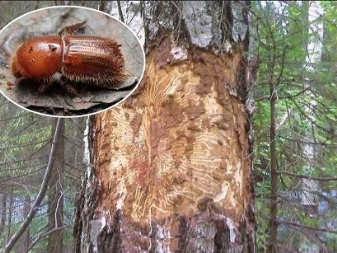
What if a young pine tree dies?
The top of the tree turns yellow, and it actively throws off the crown. How to find out the cause and remove yellowness? First of all, you need to analyze the place where your pine tree grows, remember the planting procedure. Maybe the reason lies in improper care, watering, or the plant does not have enough nutrition. The pine tree requires high humidity and constant exposure to the sun. However, it does not tolerate waterlogging and can become infected with one of the types of fungal infection.
Check the root collar first. If it is closed, then free it from the earth and fallen needles. If a dense earth crust forms, loosen the soil around the trunk. It is necessary to water the pine in the early morning with settled water. If there is a drought in the yard in summer, then spray the plant. A young pine tree may not be suitable for the place you have chosen. Realizing this, it is better to transplant it into another, more suitable one.
It is advisable not to carry out top dressing for the first three years (excess fertilizers will affect health). An exception may be the case when you did not plant the tree according to the rules. As soon as you notice a nutrient deficiency, you should feed the plant with coniferous fertilizer.
To prevent the chemical composition of the fertilizer from harming the trunk, water the near-trunk circle more often for a week.
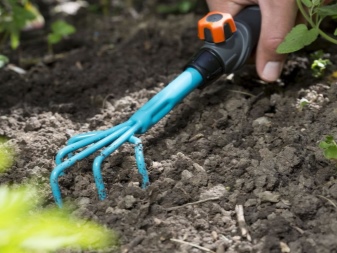

Symptoms of shute can be defined as follows: needles crumble when touched, red and brown needles appear, and brown spots appear on the trunk. If such symptoms are found, it is necessary to remove the fallen needles from the trunk - it promotes the growth of the fungus - and treat the tree with a special compound (Benomil, colloidal sulfur, Bayleton). A for prevention, twice a year - in autumn and spring - sprinkle peat or ash around the tree.
A more difficult case if rust appears. At the same time, the bark of the plant cracks, and orange-yellow bubbles appear from the cracks. It is a chronic disease that leads to death. But if you treat the plant in time, you can save it or revive it. To do this, clean the wound and treat it with copper sulfate (5%), then apply a protective compound on top.
A plaque has formed on the pine. What is it? Your plant was attacked by Hermes, which suck out all the juices from the plant. To avoid the death and further reproduction of parasites, treat the tree with "Karbofos" three times. The break between procedures should be two weeks. Bark beetles and bark beetles are those parasites that are very difficult to destroy. Often, drugs that are sold in stores do not work on them. If a plant is dear to you, then seek help from specialists from forestry.
You can reanimate a pine tree like this: cut off the affected branches and burn them. In other cases, conventional insecticides will help.

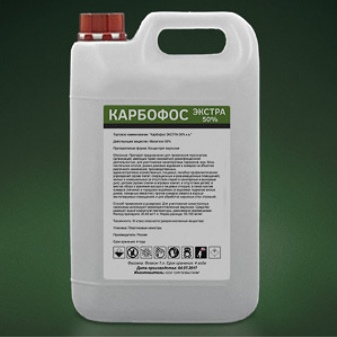
In order to avoid problems, it is better to do prevention. It should start from the very planting of the plant. Choose the right place for your seedling in your garden. Create the right microclimate. A number of the following measures will also help in this matter.
- In the fall, it is necessary to saturate the plant with moisture, and during the warm season, observe the watering regime.
- Compliance with the rules of feeding. It should be started three years after planting.
- The planting must have a solar light source that meets all of its requirements.
- It is necessary to protect the tree from the cold in time. To do this, cover it with a special material for the winter.
- Prevent disease and destroy parasites with fungicides and insecticides.
About why pine needles turn yellow and how to deal with it, see the next video.



































































The comment was sent successfully.